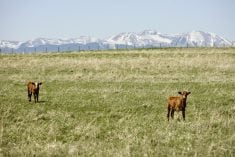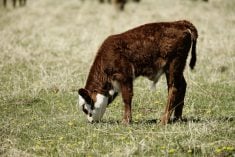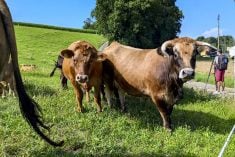In the cold, wet pastures of a gruelling Manitoba spring near Oakville, Man., Garth McCormick needed a calf to put on one of his cows who had lost her calf, but didn’t have any he could use on his own farm. His hired man brought a calf from his own place to McCormick’s. Immediately, the calf started sucking, and despite the snow and rain, McCormick thought they would be okay.
“It wasn’t as thrifty as I thought it might be, but I thought it’d be fine,” McCormick says.
“It just kept going downhill from there.”
Read Also

Canadian Beef Check-Off Agency reports on investments and activities
The check-off agency’s work behind the scenes is what ensures cattle check-off dollars are invested wisely, accounted for transparently and deliver measurable value back to producers and importers.
Despite the initial success of moving the calf, it soon grew ill and passed away, and it wasn’t the only one. McCormick noticed more of his calves becoming sick at a rapid rate. The calves became weak and lethargic, each with varying cases of diarrhea. Despite all McCormick’s efforts, many of the calves died.
and the measures he took to eliminate further spread.
The diagnosis
When prompted by his vet to take the calf to the University of Manitoba for testing, McCormick’s worst fears came to light — the calf tested positive for Cryptosporidium parvum, originally from the calf they’d brought into the yard.
“(Cryptosporidium parvum) is primarily a dairy disease,” McCormick says. “The young lad that works for me had been dealing back and forth with dairy calves from a dairy through the winter. And even though that calf that I got was only at his place for a day, it got crypto.”
According to the Western College of Veterinary Medicine (WCVM) at the University of Saskatchewan, Cryptosporidium parvum, often called crypto, is a parasite that affects calves. It is one of four types of the Cryptosporidium parasite. Infection is caused by ingesting oocysts of the parasite. Calves who suffer from this parasite often experience profuse diarrhea and dehydration, as well as lethargy and weakness. In severe cases, the calves may die.
According to the Merck Veterinary Manual, transmission may occur in a variety of ways; either from calf-to-calf, or indirectly through people or objects. Fecal contamination of feed or water can also spread the disease. In a study conducted in the U.K. and published through Parasitology Research, researchers found that warm and wet weather, alongside keeping the cattle in organic production, increased crypto risk.
“The calf looks good and all of a sudden it just drops,” McCormick says. “You had to go through the pen twice a day and just get them up, and if they were wobbly and whatnot, you knew they were getting dehydrated.”
Crypto hit McCormick’s herd hard. After the first calf got sick, they all seemed to start dropping.
“We lost a high percentage,” he says. “So we probably lost at least 25 per cent of the last half of the calf crop.”
Crypto in dairy cows
Dr. Roy Lewis, an Alberta-based vet who specialized in large-animal practice, says crypto affects dairy cattle more than beef cattle because dairy cows are often kept in closer proximity to each other.
“(Crypto) can kind of spread even though they’re often in individual hutches and stuff, which you think would help with not spreading it, but again, they still have contact. And then it depends on if the hutches are cleaned in between calves, that sort of thing,” Lewis says.

However, dairy farmers have an easier time treating crypto. The closer proximity of the cattle makes it easier to administer the treatment. Because dairy herds are usually on concrete floors, the parasite can’t get into the soil. In contrast, beef calves are more spread out during calving season and are born onto soft ground, allowing the parasite to get into the soil.
“(Calves) need to be treated a few days in a row,” Lewis says, adding that usually nearby calves should be treated preventatively as well. This is easier to do in a dairy herd, where calves are housed individually or with a buddy, he adds, than in a beef herd on the range.
With the wet spring McCormick faced in Manitoba, the disease buried deep into the ground.
When the parasite gets into the ground, it is almost impossible to remove it. This is the issue McCormick is currently facing.
“If it ever dries up, we’re going to try and clean the yard up real well,” McCormick says. “Sunlight will get rid of some but there’s still going to be some way down in the muck that the cattle milled into the soil. So we’re probably always going to have it.”
Lewis says always having it in the soil is a possibility. Managing manure in the calving area for early calvers helps, as does spreading out the calves.
Treatment
Currently, there is no cure for the disease. The Merck Veterinary Manual states that experimental treatments have mostly been toxic or ineffective. However, Lewis says producers can use Halocur or Toltrazuril.
Originally used for the treatment of coccidiosis, Toltrazuril is a pill that can be used for both young and older calves.
“In Western Canada for the last probably 10-plus years, Toltrazuril has been used at birth … as a preventative for coccidiosis,” Lewis explains. “And they found that at least in the field, that it seems to work really well for crypto, so there is a ton of producers who in Western Canada are using it preventatively at birth.”
Halocur, on the other hand, is designed for crypto but is used less frequently because it has a higher chance of harming the calves.
“Halocur is probably one of the least-safe products out there to be used,” Lewis says. “So in other words, if we double the dose by accident the calf will definitely get sick. So that’s a pretty narrow safety margin.”
But these treatments aren’t the only way to try to combat the disease. Giving the calves extra nutrients and electrolytes also helps them fight crypto.
“One thing I didn’t do that I found out later is that, if they weren’t sucking the cow, I should have been giving them nourishment in milk of some sort — like a formula, colostrum or something — just to try and get them the nourishment,” says McCormick.
Dr. Eugene Janzen, a vet based out of Calgary and a professor emeritus at the University of Calgary’s faculty of veterinary medicine, says researchers are looking into how passive transfer might help calves with crypto.
“If you can get colostrum into those calves early, you do provide a bit of passive immunity,” Janzen says. “I know that there’s a lot of work going on with that. There’s a lot of work going on with vaccinating for other organisms. And of course, that’s one thing about crypto, is that if you’ve got rotavirus or coronavirus at any level at all, that can exacerbate the effects of crypto.”
People who deal with cattle who have crypto need to be careful, too. Cryptosporidium parvum is a zoonotic pathogen, meaning it can be passed from animals to humans. While it usually isn’t fatal to humans, it can make them quite ill, with the same symptoms the calves experience.
“What makes parvum so unique, is — on a ranch or in a veterinary clinic, or even a pathology lab — if you have an outbreak of that particular organism, you can bet that your employees will be at risk, or any humans that are dealing with those calves,” Janzen says.
Prevention
To prevent crypto from infecting your own cattle, Lewis reiterates the importance of not bringing in cattle from outside your herd. Avoiding dairy calves is one recommendation, but Lewis says they also “frown on” bringing in beef calves from other operations or auction marts.
“In the spring, try to use calves that you have internally, like twins and that sort of thing, that you can rob one and put it on another cow.”
For McCormick, as he continues to struggle with the effects of Cryptosporidium parvum on his herd, this is his biggest regret — and his most important message to other producers.
“Bringing outside animals into your herd is a high-risk venture. And I didn’t realize how high risk until we’re in a situation right now. So if I can convince somebody else that it’s too high-risk a scenario, that just do without the calf, then that’s really all it is. I didn’t realize until it was too late.”

















